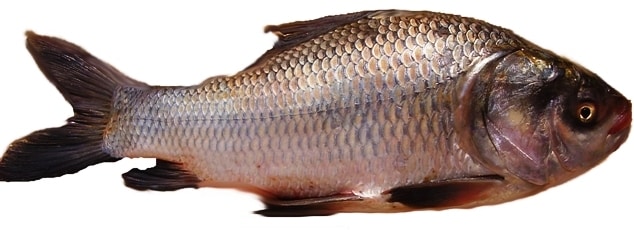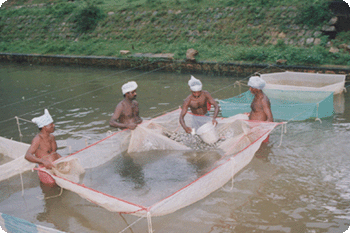Catla Fish Farming Info:

Introduction of Catla Fish Farming:- Catla fish is one of the very popular fresh water fishes grown throughout India and identified as a Indian carp. The commercial farming of catla fish is very high due to its fast growth and market demand. This fish belongs to the family of “Cypriinidae” and genus of ‘Catla’. The advantage of this fish is its fast growing nature, taste and nutrition. This fish is also known as “bhakura” in India. This fish has 3 scientific names such as catla catla, Gibelion catla and Cyprinus catla. Catla fish is native to India, Bangladesh, Pakistan, Nepal and Myanmar. Catla fish is commonly found in rivers, canals and the breeding percentage is very good. This fish can also be grown commercially in fresh water ponds. Catla commercial farming in freshwater pond is very profitable as these fish are hardy and grow very fast by eating surface feed. It is recommended to culture this fish along with other carp species like rohu and mrigala.
Local Names of Catla Fish in India:- Bhakur, Boassa, Chepti, Katla, Tambra (Hindi, Marathi), Botcha (Telugu), Katla, Thoppu meen (Tamil), Katla (Kannada), Karakatla, Katla (Malayalam), Katla, Pla Kra Ho (Bengali), Thambra (Gujarati).
Catla Fish Breed Characteristics:- The most distinguish feature of the catla fish is it’s larger lower jaw and this forces its lower lip to be upturned.
- Catla upper lip is thicker than lower lip.
- Catla body is short and its head is bigger than rohu fish.
- Catla fish back is more convex than their belly area.
- Catla fish fins are black coloured.
- Catla fish mouth is big compared to other Indian carp.
Breeding in Catla Fish Farming:- Generally, catla fish comes to maturity level at the age of 3 to 4 years. On an average, a female catla fish contains about 2 to 3 million eggs. In the natural or wild areas like rivers, reservoirs, they breed especially in rainy season (June to July). For commercial farming of catla fish, artificial breeding is done in fish hatchery and fingerlings can be raised in fish nurseries. As commercial fish farming requires large amount of seed, this can be fulfilled by hatchery or fisheries.
Seed Collection in Catla Fish Farming:- The commercial Catla fish breed culture is very common and Induced breeding is playing major role for entire seed requirement in all the countries .However, seed source is available from rivers, lakes, reservoirs, canals and other water bodies. Local hatcheries are the source for main seed collection.
Rearing Fingerlings in Catla Fish Farming:- Catla fry should be reared along with mrigala and rohu fish @ equal proportions with combined density of 0.2 to 0.3 million fry per 1 hectare. Generally, the nursery raised fry of 25 mm length catla should be reared further for the length of 100 mm and weight of 10 grams fingerlings to grow in main pond.
Pond Construction in Catla Fish Farming:- Attention should be given while constructing a pond for commercial catla fish farming. One should not stock catla fish heavily in the pond & stocking always depends on the fish size and area of the pond. Catla fish grows very well at water temperatures between 25 °C to 35 °C.
Seed Stocking and Fertilizers in Catla Fish Farming:- Organic and inorganic fertilizers, supplementary feeding should be applied along with the mixture of oil cake and rice bran. The application dosage depends on the farming intensity and inherent productivity. Generally, the survival rate of catla fingerlings range from 60 to 75 %. Contact nearest aquaculture or fisheries department for exact pond manures and fertilizers.

Feeding in Catla Fish Farming:- Catla fish usually consumes food from the upper level of water. They are natural feed lovers and eat whatever insects or small plants float on the surface of the water. In the commercial catla fish cultivation, fish meal and fish feed should be supplied for getting good weight and growth. The feeding amount depends on the density of the fish in the pond. It is recommended to feed multiple times in a day rather at once.
Harvesting in Catla Fish Farming:- Fish can be collected from the pond by using the fishing nets to collect the fish from pond when they gain at least 500 grams. Generally catla fish has good market demand when they gain about 1 to 2 kg each. Harvesting can be done based on the fish size and market demand.
Market Demand for Catla Fish:- In India, Most of the people love to eat fish like catla due to its taste and availability. Especially, in south India, usually people make fish fry or fish curry with catla fish. Even some people make fish pickle which lasts for longer period of time. The regular market price for catla fish is about 140 to 150 rupees per kg. Depending on the size , farmers can market catla fish locally.
Bottom Line of Catla Fish Farming:- The commercial farming of catla fish is very profitable.
For Tilapia Fish Farming : Read Here.
For Murrel Fish arming : Read Here.
For Sheep or Goat Farming Info : Read Here.
Dear Sir,
Can You Suggest The Catla Fish Seeds Available In Bangalore with Address And Contact Details.
Thanking You Vasudevan
i have a close obesvation that catla do not engulf 2mm or bigger size palleted fish feed ..sir do you have any article reserch on perticular catla fish inner mouth and filtering etc. please provide me.
Hai Sir, I want catla fish seeds, pls send the u r a Address